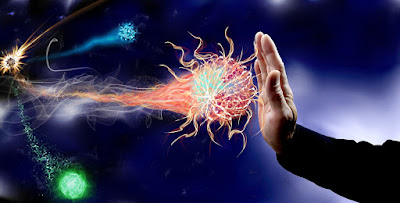Recent discoveries of retroviruses point to Design
https://med.stanford.edu/news/all-news/2015/04/viral-proteins-may-regulate-human-embryonic-development.htmlExcerpt: "A fertilized human egg may seem like the ultimate blank slate. But within days of fertilization, the growing mass of cells activates not only human genes but also viral DNA lingering in the human genome from ancient infections.
Now researchers at the Stanford University School of Medicine have found that the early human cells produce viral proteins, and even become crowded with what appear to be assembled viral particles. These viral proteins could manipulate some of the earliest steps in human development, affecting gene expression and even possibly protecting the cells from further viral infection.
Now the Stanford researchers have shown for the first time that viral proteins are abundantly present in the developing human embryo and assemble into what appear to be viral particles in electron microscopy images. By following up with additional studies in human embryonic cells grown in vitro, scientists showed that these viral proteins affect gene expression in the developing embryo and may protect the cells from infection by other viruses.
Battle or symbiosis?
But it’s not clear whether this sequence of events is the result of thousands of years of co-existence, a kind of evolutionary symbiosis, or if it represents an ongoing battle between humans and viruses.
“Does the virus selfishly benefit by switching itself on in these early embryonic cells?” said Grow. “Or is the embryo instead commandeering the viral proteins to protect itself? Can they both benefit? That’s possible, but we don’t really know.”
Grow and his colleagues found that some HERVK viruses are transcribed into RNA — the first step in making proteins based on the blueprint provided by DNA— in 3- to 4-day-old embryos. This viral activation coincides with the activation of other key human genes in the embryo. The researchers then used electron microscopy to observe what appear to be intact viral particles in human blastocysts, which arise within five to six days after fertilization.
HERVK also encodes a viral protein called Rec, which binds to viral RNA transcripts made from DNA sequences, and escorts the transcripts to the ribosomes in the cells’ cytoplasm to be made into proteins.
Researchers found that Rec not only affected the expression of viral genes, but it also binds to many RNAs made from human genes. Rec also modulates the RNAs’ interactions with the ribosomes. Finally, the presence of Rec in human cells stimulated an immune response that increased the amount of a surface-bound human protein called IFITM1, which protects the cells from viral infection.
‘A potentially beneficial strategy’
“There is a long-standing debate within the field of genome evolution,” Grow said. “Why retain so much seemingly useless and repetitive DNA within our genomes? Our results demonstrate a tangible and physiologically relevant phenotype — improved antiviral immunity. This clearly implicates HERVK expression in the embryo as a potentially beneficial strategy.”
Another study confirms that endogenous retroviruses is a mechanism controlled by the immune system:
https://www.tandfonline.com/doi/full/10.1080/2159256X.2016.1165785
My comment: Virus infections could be a catastrophe for a developing embryo. That's why there has to be a solid mechanism that protects embryonic cells. This is done by accurate control by the immune system that uses viral dna sequences as a memory and produces short piRNA molecules for accurate expression or silencing of those viral DNA sections. There's no junk-DNA in the genome because DNA is just passive information but it can be modified and recycled for other purposes. Endogenous retrovirus strands are epigenetically controlled and regulated. Disruptions in this regulation might result in diseases. Both exogenous and endogenous retroviruses point to design, not to selfish genes. The theory of evolution is the most serious heresy of our time.
“There is a long-standing debate within the field of genome evolution,” Grow said. “Why retain so much seemingly useless and repetitive DNA within our genomes? Our results demonstrate a tangible and physiologically relevant phenotype — improved antiviral immunity. This clearly implicates HERVK expression in the embryo as a potentially beneficial strategy.”
Another study confirms that endogenous retroviruses is a mechanism controlled by the immune system:
https://www.tandfonline.com/doi/full/10.1080/2159256X.2016.1165785
Excerpt:"Considering this, transcript reversion-mediated interference with related viruses may be a novel type of antiviral immunity in vertebrates. Understanding the biological significance of transcript reversion will provide novel insights into host defenses against viral infections."
"In complex with a PIWI clade argonoute protein, piRNA targets transposons with complimentary sequences for transcriptional and post-transcriptional silencing."
"In complex with a PIWI clade argonoute protein, piRNA targets transposons with complimentary sequences for transcriptional and post-transcriptional silencing."
My comment: Virus infections could be a catastrophe for a developing embryo. That's why there has to be a solid mechanism that protects embryonic cells. This is done by accurate control by the immune system that uses viral dna sequences as a memory and produces short piRNA molecules for accurate expression or silencing of those viral DNA sections. There's no junk-DNA in the genome because DNA is just passive information but it can be modified and recycled for other purposes. Endogenous retrovirus strands are epigenetically controlled and regulated. Disruptions in this regulation might result in diseases. Both exogenous and endogenous retroviruses point to design, not to selfish genes. The theory of evolution is the most serious heresy of our time.
